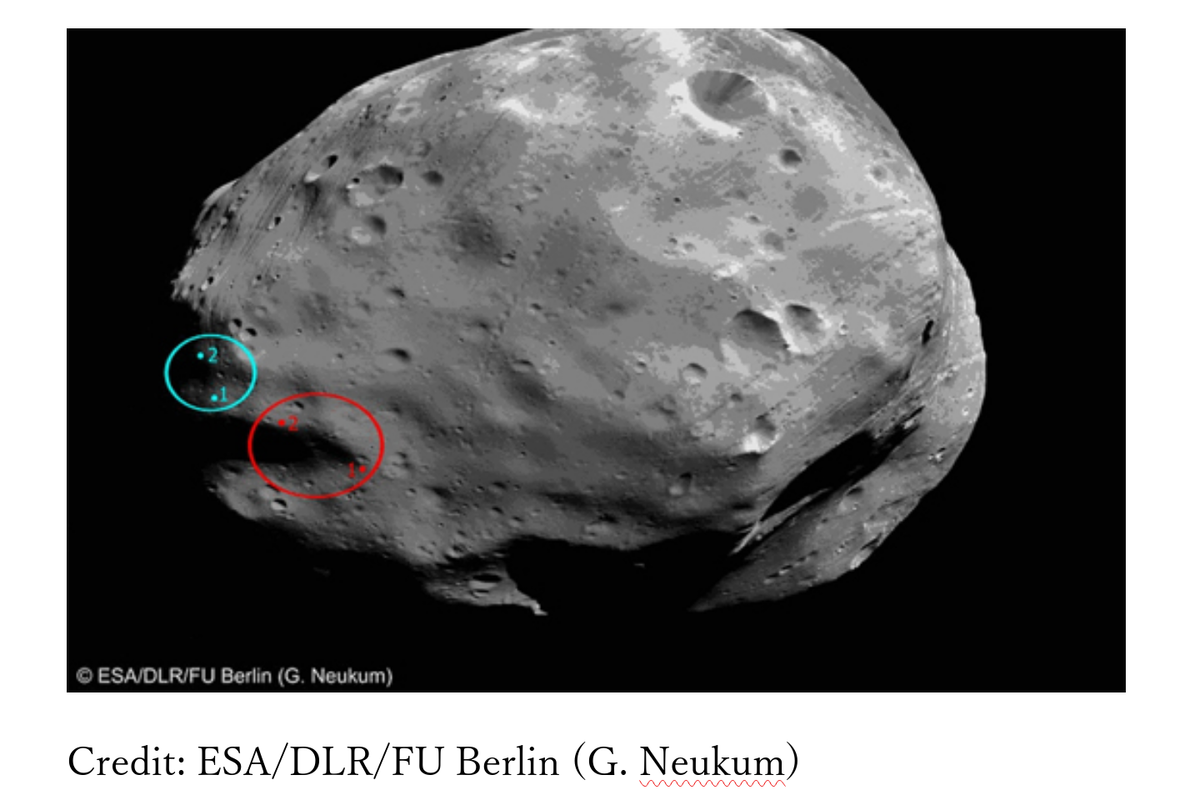ザ・サンダーボルツ勝手連 [Phobos-Grunt フォボス・グラント(低く唸るフォボス)]
[Phobos-Grunt フォボス・グラント(低く唸るフォボス)]

Previously considered (blue) and current mission landing sites.
以前に検討された(青)および現在のミッション着陸地点。
―――――――
Aug 04, 2011
ロシアの宇宙ミッションは、サンプル・リターン・パッケージをフォボスに着陸させようとしています。
2011年10月、ロシアの宇宙機関であるロスコスモスは、火星に向けて科学機器パッケージを打ち上げ、2013年3月または4月に最大の月衛星に着陸する予定です。
小さな着陸船は、表面のサンプルを収集し、地球の帰還車両とのランデブーのために爆破します。
フォボスとデイモスは火星の2つの月衛星ですが、ダイモスはとても小さいので、地球からはなかなか観測できません。
1976年にバイキング2オービターだけがクローズアップ画像を撮影しました。
フォボスは、地球ベースの望遠鏡と火星軌道の人工衛星によって広く研究されてきました。
火星に関する「今日の写真」の記事は、火星がかつてマリネリス峡谷を掘り出すのに十分な大きさのプラズマ炎に浸されたことを示しています。
数百万立方キロメートルの岩と塵が脱出速度で惑星から吹き飛ばされました。
マンハッタン島よりも大きな石のブロックは、大きな高さから火星に落下し、衝撃で粉々になりました。
これは、数百万平方キロメートルをカバーする鋭いエッジを持つ巨大な岩のフィールドを説明しています。
フォボスやデイモスのような月衛星や、アイダのような小惑星も、その大変動から生まれたのでしょうか?
スティックニー・クレーターは、フォボスの1つの半球を支配します。
幅10キロメートル、深さ100メートル以上です。
「今日の写真」の多くの以前の記事は、大きなクレーターを小さな天体の上で爆破することに関連する物理的な問題に言及します。
たとえば、小惑星253マティルドには、それを崩壊させたはずの穴があります。
フォボスのサイズはわずか28x 20キロメートルなので、スティックニーはほぼ半分の大きさです。
科学者達は、小惑星(そしておそらく小さな月衛星)は、宇宙の砂利採取場に似た、岩石と土壌の緩い集合体であると推測しています。
それらは流星の衝突から吹き飛ばされなかったので、彼らはおそらく砂の山のように振る舞い、衝撃を和らげたと考えられています。
砂利積み理論は事実に最もよく当てはまりますか?
フォボスは小惑星マティルドとほぼ同じサイズなので、比較的巨大なクレーターのように、そもそもオブジェクトを破壊することなく同様の構造を形成できる一般的なイベントはありますか?
答えは電気です。
太陽系の電気的歴史には、非常にエネルギッシュな出来事や、帯電した惑星と月衛星の間の激しい相互作用が含まれます。
電気アークが物質を簡単に除去できることは、VEMASAT(ベマサット)ラボラトリーズのDr. C. J.ランソムによって実施された実験によって証明されています。
彼のプラズマ放電は、表面のくぼみを掘削し、物質をすくい取り、それを空中に爆発させて、きれいにカットされた特徴を残します。
火星を刻んだ稲妻は、その地殻の大きな塊をその周りの軌道に投げ込み、同様に太陽の周りに送りました。
過去の天体災害に伴う、その電場は、プラズマ放電によってそれらを滑らかにし、侵食しました。
その結果、ポボスと言及された小惑星は、塵で覆われています、それらは、は巨大なクレーターによって定義されており、半分溶けているように見えます。
フォボスとデイモスは、彼らの親惑星を電気的に破壊した壊滅的な出来事の残骸であるように見えます。
Stephen Smith
スティーブン・スミス
―――――――
Aug 04, 2011
A Russian space mission will attempt to land a sample return package on Phobos.
ロシアの宇宙ミッションは、サンプル・リターン・パッケージをフォボスに着陸させようとしています。
In October 2011 the Russian Space agency, RosCosmos, will launch a scientific instrument package toward Mars, with a planned landing on its largest moon in either March or April of 2013.
2011年10月、ロシアの宇宙機関であるロスコスモスは、火星に向けて科学機器パッケージを打ち上げ、2013年3月または4月に最大の月衛星に着陸する予定です。
The small lander will gather samples of the surface and then blast off for a rendezvous with an Earth return vehicle.
小さな着陸船は、表面のサンプルを収集し、地球の帰還車両とのランデブーのために爆破します。
Phobos and Deimos are the two moons of Mars, although Deimos is so small it cannot be readily observed from Earth.
フォボスとデイモスは火星の2つの月衛星ですが、ダイモスはとても小さいので、地球からはなかなか観測できません。
Only the Viking 2 orbiter captured close up images in 1976.
1976年にバイキング2オービターだけがクローズアップ画像を撮影しました。
Phobos has been extensively studied by Earth-based telescopes and by satellites in Mars orbit.
フォボスは、地球ベースの望遠鏡と火星軌道の人工衛星によって広く研究されてきました。
Picture of the Day articles about Mars have shown that it was once immersed in a plasma flame sufficiently large to gouge out Valles Marineris.
火星に関する「今日の写真」の記事は、火星がかつてマリネリス峡谷を掘り出すのに十分な大きさのプラズマ炎に浸されたことを示しています。
Millions of cubic kilometers of rock and dust were blasted out from the planet at escape velocity.
数百万立方キロメートルの岩と塵が脱出速度で惑星から吹き飛ばされました。
Stone blocks larger than Manhattan Island fell back to Mars from a great height, shattering on impact.
マンハッタン島よりも大きな石のブロックは、大きな高さから火星に落下し、衝撃で粉々になりました。
This explains the fields of enormous boulders with sharp edges covering millions of square kilometers.
これは、数百万平方キロメートルをカバーする鋭いエッジを持つ巨大な岩のフィールドを説明しています。
Could it be that moons like Phobos and Deimos, as well as asteroids like Ida, were also born from that cataclysm?
フォボスやデイモスのような月衛星や、アイダのような小惑星も、その大変動から生まれたのでしょうか?
Stickney crater dominates one hemisphere of Phobos.
スティックニー・クレーターは、フォボスの1つの半球を支配します。
It is 10 kilometers wide and more than 100 meters deep.
幅10キロメートル、深さ100メートル以上です。
Many previous Picture of the Day articles mention the physical problems associated with blasting large craters into small bodies.
「今日の写真」の多くの以前の記事は、大きなクレーターを小さな天体の上で爆破することに関連する物理的な問題に言及します。
For example, there is a hole in asteroid 253 Mathilde that should have caused it to disintegrate.
たとえば、小惑星253マティルドには、それを崩壊させたはずの穴があります。
Phobos is a mere 28 by 20 kilometers in size, so Stickney is nearly half as big.
フォボスのサイズはわずか28x 20キロメートルなので、スティックニーはほぼ半分の大きさです。
Scientists speculate that asteroids (and perhaps small moons) are loose aggregations of rocks and soil, similar to a gravel pit in space.
科学者達は、小惑星(そしておそらく小さな月衛星)は、宇宙の砂利採取場に似た、岩石と土壌の緩い集合体であると推測しています。
Since they were not blown apart from meteor impacts, it is thought that they most likely behaved like a pile of sand, cushioning the shock.
それらは流星の衝突から吹き飛ばされなかったので、彼らはおそらく砂の山のように振る舞い、衝撃を和らげたと考えられています。
Does the gravel pile theory best fit the facts?
砂利積み理論は事実に最もよく当てはまりますか?
Since Phobos is about the same size as asteroids Mathilde, Eros and Ida, exhibiting the same features like relatively gigantic craters, is there a common event that can form similar structures without obliterating the objects in the first place?
フォボスは小惑星マティルドとほぼ同じサイズなので、比較的巨大なクレーターのように、そもそもオブジェクトを破壊することなく同様の構造を形成できる一般的なイベントはありますか?
The answer is electricity.
答えは電気です。
The electrical history of the solar system includes intensely energetic events and violent interactions between charged planets and moons.
太陽系の電気的歴史には、非常にエネルギッシュな出来事や、帯電した惑星と月衛星の間の激しい相互作用が含まれます。
That electric arcs can remove material with ease is proven by the experiments conducted by Dr. C. J. Ransom of VEMASAT Laboratories.
電気アークが物質を簡単に除去できることは、VEMASAT(ベマサット)ラボラトリーズのDr. C. J.ランソムによって実施された実験によって証明されています。
His plasma discharges excavate surface depressions, scoop out material, and explode it into the air, leaving cleanly cut features.
彼のプラズマ放電は、表面のくぼみを掘削し、物質をすくい取り、それを空中に爆発させて、きれいにカットされた特徴を残します。
The lightning bolts that carved Mars threw large chunks of its crust into orbit around it, as well as sending them around the Sun.
火星を刻んだ稲妻は、その地殻の大きな塊をその周りの軌道に投げ込み、同様に太陽の周りに送りました。
The electric fields that accompanied the celestial disasters of the past smoothed and eroded them with plasma discharges.
過去の天体災害に伴う、その電場は、プラズマ放電によってそれらを滑らかにし、侵食しました。
The result is that Phobos and the asteroids mentioned are covered in dust, are defined by huge craters, and look like they're half-melted.
その結果、ポボスと言及された小惑星は、塵で覆われています、それらは、は巨大なクレーターによって定義されており、半分溶けているように見えます。
Phobos and Deimos appear to be remnants of a catastrophic event that electrically devastated their parent planet.
フォボスとデイモスは、彼らの親惑星を電気的に破壊した壊滅的な出来事の残骸であるように見えます。
Stephen Smith
スティーブン・スミス